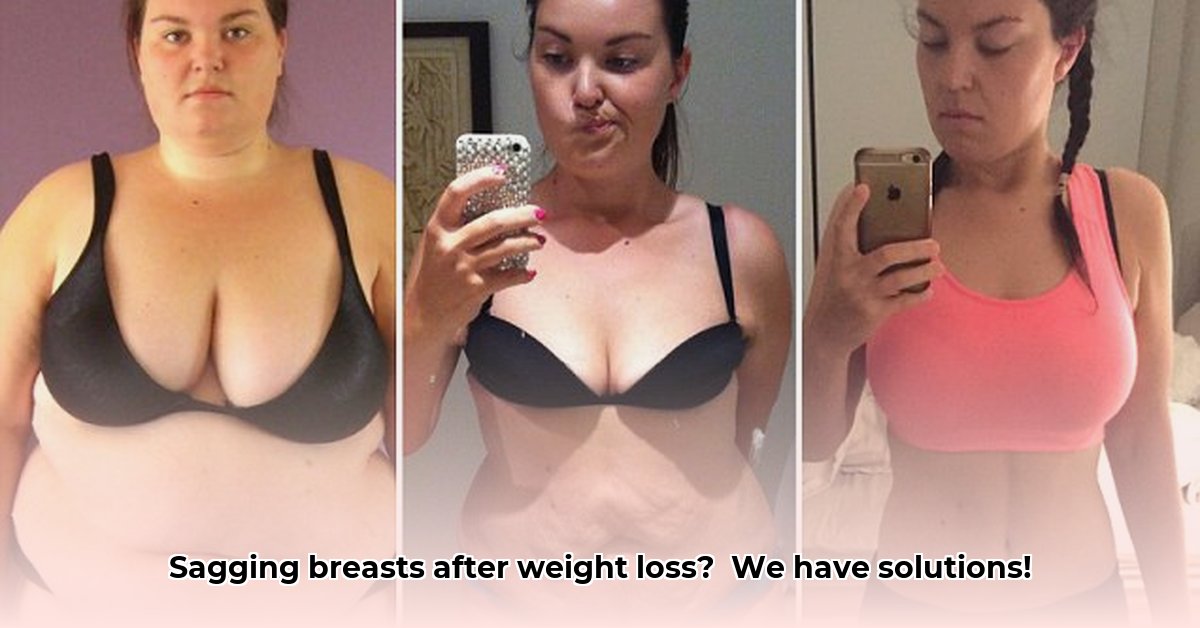
Congratulations on your weight loss journey! This is a significant accomplishment, but for many women, a noticeable side effect is breast sagging. This comprehensive guide will explore the causes, preventative measures, and treatment options available to help you regain confidence and feel comfortable in your own skin.
Understanding Breast Sagging After Weight Loss
Significant weight loss often leads to breast sagging. This isn't a sign of failure; it's a natural consequence of reduced fat volume in the breasts. Think of your breasts as balloons—when the fat (air) is reduced, the supporting structures (skin and ligaments) become loose and sag.
The Science Behind the Sag
Breasts are primarily composed of fatty tissue, glandular tissue, and supporting ligaments. Weight loss reduces the fat content, causing the breasts to shrink. The skin and ligaments, which have been stretched, lose their elasticity, resulting in sagging. Several factors influence the degree of sagging, including age (older skin is less elastic), genetics, initial breast size (larger breasts tend to sag more), and the rate of weight loss. Rapid weight loss typically leads to more noticeable sagging.
Addressing Breast Sagging: A Multifaceted Approach
Fortunately, there are various approaches to address breast sagging after weight loss, ranging from simple lifestyle changes to more involved medical interventions.
Non-Surgical Approaches: Simple Steps, Big Impact
Several non-surgical methods can help improve breast appearance and firmness.
The Right Bra: A well-fitting, supportive bra is crucial. It provides lift and reduces strain on the ligaments. Consider seeking professional bra fitting for optimal support. Dr. Emily Carter, a board-certified plastic surgeon at the Center for Cosmetic Surgery, emphasizes, "A properly fitted bra is essential for providing support and minimizing further sagging. This is a simple yet effective step often overlooked."
Strengthening Exercises: Chest exercises can tone the pectoral muscles, offering additional support. Push-ups, dumbbell presses, and chest flyes are excellent choices. Always start slowly and gradually increase intensity. Consult a physical therapist for guidance to prevent injury.
Healthy Habits for Healthy Skin: Maintaining a balanced diet rich in protein, antioxidants, and healthy fats is vital for skin elasticity. Stay hydrated by drinking plenty of water. Regular exercise also promotes healthy skin and overall well-being. As noted by Dr. Sarah Miller, a dermatologist at the University of California, San Francisco, "Nutrition plays a critical role in skin elasticity. Prioritizing a diet rich in collagen-boosting nutrients can contribute to improved skin health."
Topical Treatments: While many topical creams promise to tighten skin, scientific evidence supporting their long-term effectiveness on breast sagging is limited. Consult your dermatologist before using any topical treatments. Research is ongoing in this area.
Surgical Options: A More Involved Approach
If non-surgical approaches are insufficient, surgical options may be considered.
Breast Lift (Mastopexy): This procedure removes excess skin and lifts the breasts, improving their shape and firmness.
Breast Augmentation: This involves adding implants to increase breast size and fullness.
Both procedures are significant surgical interventions requiring careful consideration of risks, recovery time, and personal expectations. Consult a qualified plastic surgeon for a thorough assessment and informed consent.
How to Prevent Breast Sagging After Significant Weight Loss
Preventing breast sagging isn't about reversing the effects of weight loss, but rather mitigating them. A multi-pronged approach focusing on gradual weight loss, targeted exercise, proper bra support, and a healthy lifestyle can significantly reduce the risk of excessive sagging.
1. Gradual Weight Loss: The Gentle Approach
Losing weight gradually (1-2 pounds per week) minimizes skin stretching. This allows your skin to adapt more effectively to the changes in breast size.
2. Strengthening Your Chest: Exercise is Key
Incorporate chest-strengthening exercises like push-ups, dumbbell presses, and chest flyes into your routine. Consult a fitness professional to create a safe and effective program.
3. The Power of a Supportive Bra
Wear a well-fitting, supportive bra throughout the day, even during low-impact activities. Regularly check your bra size to ensure optimal support.
4. Nourishing Your Skin: Inside and Out
Maintain a healthy diet and drink plenty of water. Consider incorporating collagen-boosting foods into your diet.
5. Professional Guidance: When Needed
If you’re concerned about breast sagging, don't hesitate to seek guidance from a healthcare professional. They can provide personalized advice and recommendations.
Remember: While some degree of sagging is natural after significant weight loss, proactive measures can minimize its impact and boost your confidence. Celebrate your achievement and focus on your overall well-being.